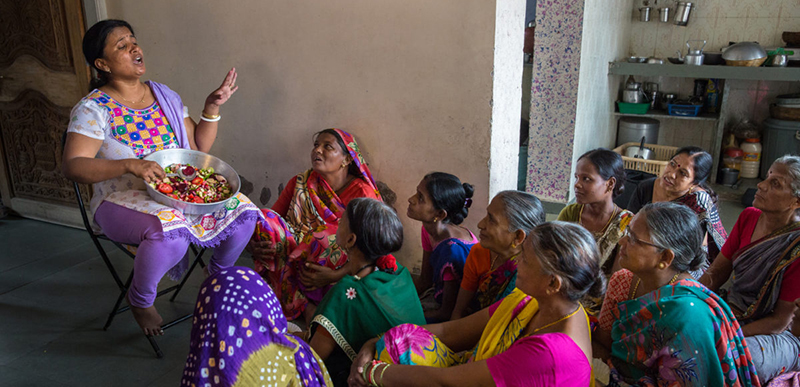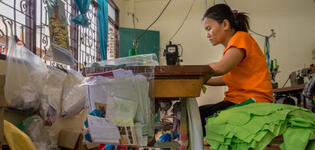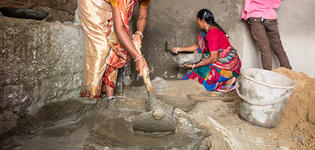Blog
A fiercely contested omission — or why we need to keep talking about unpaid care
In the late 1950s, the United Nations System of National Accounts was set up to promote the collection of internationally comparable data on productive activity in different countries. The aim was to provide the basis for policy-making, including estimating the gross national product (GNP), the main measure of progress. However, unpaid care work, disproportionately carried out by women across the world, was not included — an omission that, despite fierce criticism, continues to the present day.
We are now going through a period in which lives and livelihoods are being severely disrupted by COVID-19. It has become clear that women are not only losing their jobs in larger numbers than men, but taking on an even greater share of unpaid care work. Not surprisingly, reports suggest that women are experiencing higher levels of anxiety, depression, overwork, and ill-health. The arbitrariness and injustice of this omission has never been more glaringly obvious. It therefore seems appropriate on this International Women’s Day, two years into the pandemic, to revisit its history.
System of National Accounts
The idea of the System of National Accounts (SNA) was first proposed by a UN Expert Committee of five men in a 1953 report. It spoke of the policy importance of information about the workings of the economic system ‘as a whole’ and the way in which its different parts were related to each other. It proposed countries construct ‘production boundaries’ for their economies to separate out activities that counted as part of the economic system from those that did not and could be ignored.
The original definition of productive activity was derived from developed market economies: any work that was carried out for pay or profit. This definition essentially excluded much of the non-marketed subsistence activity that dominated the rural economies of the Global South.
An early objection to this definition came from a 23-year-old graduate researcher, called Phyllis Deane, who had been hired to test the incipient national accounts methodology in a number of African countries. She quickly found out that not only did it exclude a great deal of subsistence work in these countries, but that a disproportionate amount of this work was typically done by women. She concluded that if governments wanted policies that increased national income but also ensured equitable distribution, the production boundary would have to include the non-market work done by women.
Her conclusions were ignored by her advisors when they drew up their report. But the groundswell of criticism from various sources has meant that the production boundary is periodically extended to include various forms of non-marketed activity, with market prices used to impute their value. Unpaid care work however continues to be excluded.
Various reasons for this omission have been advanced by the technical experts who advise on the SNA. An early one was that ‘housewives’, by definition, were not primary producers and their non-market work was ‘of little or no importance’. Marilyn Waring who has written extensively about the patriarchal reasoning behind the SNA said that it took her several years to get over the absurdity of this statement.
Why it matters
The interactions between women’s unpaid care work and the market economy have major implications for gender equality outcomes. Two common measures are women’s labour force participation relative to men’s and the gender gaps in pay and in quality of work. Research on the drivers of these outcomes consistently points to the central role that unpaid care work plays in determining their levels.
Powerful ideologies about the male breadwinner define women’s roles primarily in terms of their domestic responsibilities, making it difficult for women to choose otherwise. These prior claims on women’s time have significant consequences for their relationship with the market economy.
First, they curtail women’s capacity to participate in the market economy. Around the world, women’s labour force participation rates are lower than those of men; in other words, they are prevented from participating in the economy that ‘counts’. When women do engage in the market economy, they must do so on disadvantaged terms. Poor women in poor countries, in particular, have little choice but to combine their unpaid care responsibilities with earning a living. This means they generally work longer hours than men across the world and have less time for rest, leisure, or community participation.
The demands of unpaid responsibilities also mean that women are more likely than men to be found in poorly paid, irregular, seasonal, and part-time activities. This translates into greater poverty in old age since they will not have pensions or savings to draw on.

A representative from the Self Employed Women's Association (SEWA), a trade union for self-employed women in the informal sector, leads a nutrition programme for mothers at the BALSEWA Center. The Center holistically addresses issues for women working in the informal sector by providing affordable daycare, health check-ups and educational programmes. The Center's daycare allows SEWA members to earn essential income for their family while keeping their children in a safe educational space.
A recent UNU-WIDER study reviewed the gender gap in vulnerable employment across 101 countries and found the experience of parenthood to be one the single biggest factors driving the disparity. The reason that becoming a parent drives the gender gap is because of the additional care work it implies for mothers. Importantly, it is the fact of additional work for mothers but not for fathers that drives the gap. Other studies find motherhood to be a main driver of the gender pay gap, which typically becomes more pronounced later in workers’ careers for exactly the same reason.
Then there are the societal-level interactions between unpaid care work and the market economy(see here or here for example). Unpaid care work is a central input into the daily and inter-generational reproduction of the labour force. It reduces the costs to the government of the additional social services it would otherwise have to provide to ensure the care of the current and future labour force. It bridges gaps in infrastructure as women travel long distances to fetch fuel and water or take their children to health services. It subsidizes business by taking on the daily responsibility for feeding and caring for its workers. And it is extended not only to the current and future workforce but also to sick, disabled, and elderly. They are cared for not because they are productive, but because they matter.
If the capacity to provide unpaid care is not to take a toll on the health, wellbeing, and life choices of individual women, society has to invest in reducing the work burdens associated with care and sharing care responsibilities more fairly. But how do we persuade policy makers to do this? This takes us back to the question of what policy-relevant data looks like. Some feminists argue that it should be sufficient to use satellite accounts which measure time-use to demonstrate how much of women’s labour goes into unpaid care work — and the price that they pay for it.
Others believe that unpaid care work should be integrated into the SNA, that unless there is a monetary value attached to it, it will not be taken seriously. There is a growing market for care services that can be used to impute value to unpaid care. Given that women are generally ‘crowded’ into the paid care sector and earn very low wages, this exercise will undoubtedly undervalue unpaid care work — but it may still provide some idea of what this value might be. For instance, according to Oxfam, women and girls carry out 12.5 billion hours of unpaid work every day. Even if this was valued at minimum wage, it would still represent a contribution to the global economy of at least US$10.8 trillion a year.
That is three times the contribution of the global tech industry.
Naila Kabeer is Joint Professor of Gender and Development at the Departments of Gender Studies and Department of International Development, London School of Economics. Naila is also a Faculty Associate at LSE’s International Inequalities Institute. Her research interests include gender, poverty, social exclusion, labour markets and livelihoods, and social protection and citizenship.
The views expressed in this piece are those of the author(s), and do not necessarily reflect the views of the Institute or the United Nations University, nor the programme/project donors.
 Join the network
Join the network









